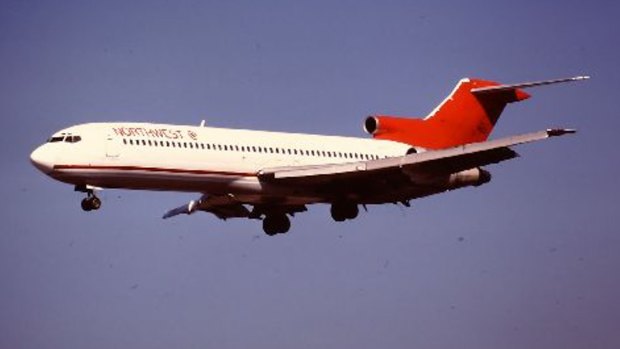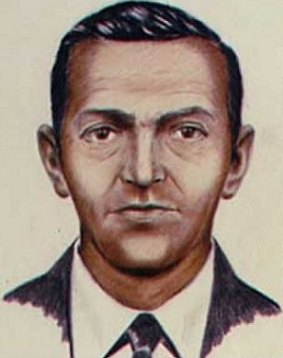This was published 6 years ago
D.B. Cooper, the mystery hijacker who jumped from an airliner and changed commercial plane design
By Michael Gebicki

Cooper leapt from a Northwest Boeing 727 similar to this.Credit: Alamy
Reality can sometimes blow fiction right out of the water, and so it is with the strange case of D.B. Cooper, the first hijacker to jump from an aircraft and into criminal mythology.
On the afternoon of November 24, 1971, a soberly dressed man in business attire approached the Northwest Orient Airlines counter at Portland International Airport and paid $20 for a one-way ticket to Seattle, Washington, using the name Dan Cooper.
He boarded the aircraft, a Boeing 727, ordered a bourbon and soda, and lit up a Raleigh cigarette. One of Raleigh's advertising slogans at the time was "Raleigh gives you both rich, mellow tobacco taste plus wonderful free gifts", which would prove oddly prescient.

The FBI sketch of the mysterious D.B. Cooper.
Shortly after take-off Cooper called flight attendant Florence Schaffner over, handed her a note saying he had a bomb and asked her to sit beside him. He opened his attache case to reveal a glimpse of wires and red tubes and demanded that she write down what he told her. On the note that Schaffner delivered to the captain, Cooper said he had a bomb and would blow up the plane and everyone in it unless he was provided with four parachutes and $US200,000 in $20 bills, worth about $1.2 million today.
The flight landed in Seattle-Tacoma Airport, the passengers and most of the crew left the aircraft which was refuelled, the money and parachutes were handed over, then Cooper made a couple of unusual requests. He asked that the aircraft take off and the pilot set a course for Mexico City flying at an altitude of 10,000 feet and maintaining an airspeed of 100 knots, roughly 185km/h, or just above stall speed. Advised that Mexico City was out of the question due to the amount of fuel the aircraft would burn in that configuration, he agreed that the destination would be Reno, Nevada. He also asked that the landing gear be left down and the cabin unpressurised.
The aircraft took off at about 7:40pm with just the pilot and co-pilot, a flight engineer and a flight attendant on board, all told to remain inside the cockpit with the door closed.
About 20 minutes after take-off, a warning light in the cockpit indicated that the rear airstair had been deployed and the crew observed a change in air pressure. This airstair extends downward from the belly of the aircraft and in line with the fuselage. Some 13 minutes later the Boeing's tail made a sudden upward movement, requiring a trim adjustment to return to level flight. This was later shown to be consistent with a human exiting the aircraft via the airstair. Two hours later the plane landed at Reno, where it was surrounded by state troopers, sheriff's deputies and the FBI, but no sign of Cooper.
The area where Cooper was thought to have landed was somewhere south of Mount St Helens in south-west Washington State, although the precise location could have been anywhere within an area of more than 200 square kilometres of rugged mountains, forests, rivers and lakes. What followed was the most expensive and elaborate manhunt in US history. FBI agents and sheriffs' deputies combed large areas of the mountainous wilderness on foot and by helicopter. Patrol boats scoured rivers and a submarine searched the depths of Lake Merwin. Following the 1972 spring thaw, FBI agents, 200 soldiers, Air Force personnel, National Guard and civilian volunteers spent more than a month searching the ground for clues, and drew a blank. No trace of Cooper, no parachute nor anything else related to the hijacking was found.
Despite enormous publicity and rewards offered by the media and government authorities, Cooper remains a mystery man, the man who never was. No missing persons have fitted Cooper's description, no friends, family members, employers or colleagues have come forward with a positive identification. No parachute schools have ever seen or heard of anyone matching Cooper's description. The initials "D.B." were appended to the name "Cooper" by the press, there never was any reason to suspect this was the hijacker's real name.
In almost five decades since the hijacking just two pieces of evidence have emerged. In 1978, a deer hunter found a placard printed with instructions for lowering the aft stairs of a Boeing 727 about 15 kilometres west of Mount St Helens, still within the potential drop zone.
Two years later an eight-year-old boy on a family holiday raked a sandy riverbank along the Columbia River to build a campfire and turned up three packets of $US20 notes, later proven to be part of the ransom money, but was it washed there or buried? And why were 10 bills missing from one of the packets, which was secured with rubber bands, just like the others?
None of the remaining 9710 remaining $US20 bills have turned up anywhere in the world. Various websites offer checks for possible matches, and any notes with matching serial numbers would be worth many times more than their face value.
Cooper had done his homework. The Boeing 727 he chose for his mission was ideal for the purpose. The aft stairwell could be deployed inflight, and by a switch from inside the cabin, which could not be overridden from inside the cockpit. The aircraft's three engines are located around the tail, allowing a fair chance of a safe jump without being incinerated in the jet exhaust. The aircraft also has a low stall speed, giving Cooper a greater safety margin. He timed his jump for the evening of Wednesday November 24. The following day was Thanksgiving, the start of a four-day holiday weekend in the USA. If you wanted to disappear for a few days and be back at work after the holiday, no questions asked, the timing was impeccable.
However the impression of a crack parachutist – possibly a former elite military paratrooper – doesn't quite gel with the facts. Cooper rejected the military parachutes that were initially offered to him in favour of sport models, even though military chutes are designed to be used at night as well as day, and in adverse weather conditions, both of which applied on that night. Cooper chose the older of the two primary parachutes supplied to him rather than the technically superior professional sport parachute. He was jumping on a cold, dark night into mountainous wilderness, with forests, water hazards and few roads. He was wearing loafers and a trench coat and the reserve parachute he took with him was a dummy used for training purposes, a fact that would have been immediately obvious to an experienced parachutist.
Weighing up the odds, speculation persists that Cooper might not have survived the jump, possibly never even deployed his chute. That same year however, among the numerous copycat hijackings that followed Cooper's, Robb Dolin Heady, a paratrooper and Vietnam veteran jumped from a United Airlines 727 near Reno, Nevada in darkness and landed safely but was apprehended the following morning as he returned to his car.
Doubt lingers. If Cooper didn't survive, why has no trace ever been found, and what about the cash bundles in the sandbar with the missing notes? The mysteries have attracted many curious and credulous minds, and theories abound.
The distinctive tie pin worn by Cooper was analysed by amateur sleuths and found to contain minute traces of titanium, a material used in the advanced sector of the airline industry at the time. This pointed the finger at a potential link to a Boeing employee, however Cooper's intimate knowledge of the Boeing 727 would have indicated the same thing, and no Boeing employee was ever implicated. Also, given the precise details of Cooper's physical appearance provide by air crew, any Boeing employee with the slightest resemblance to Cooper would immediately have been a suspect.
Tom Colbert, another would-be detective who maintains a website, DBCooper.com, claimed to have found a frayed, 45cm piece of what was possibly fire-retardant fabric in a mound of dirt in the potential drop zone, leading to suggestions this might be from a military parachute. Media outlets jumped on this "ground-breaking discovery" with unbridled enthusiasm, yet linking this so-called "new evidence" with Cooper taxes all credibility, not to mention the inconvenient fact that Cooper did not jump with a military 'chute.
In July 2016, the FBI announced that it was closing the book on D. B. Cooper, with the option to re-open the case should any legitimate physical evidence come forward. Its 60-volume case file compiled over the 45-year investigation has been preserved for historical purposes.
One outcome of the Cooper hijacking was a couple of changes in aircraft design. One was the "Cooper vane", an aerodynamic wedge that uses wind pressure to prevent an aft stairwell from being deployed inflight. The other was a mandatory peephole in the cockpit door.
See also: Is it possible for a passenger to travel on a cargo plane?
See also: 10 secrets on board planes you never knew about
Sign up for the Traveller newsletter
The latest travel news, tips and inspiration delivered to your inbox. Sign up now.